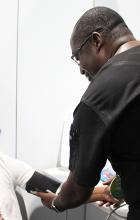About 36.7 million people suffer from high blood pressure (BP) that is not controlled, which can lead to major health conditions including heart attack, stroke and kidney failure. The nation is in need of improving its 54 percent rate of blood-pressure control among adults with hypertension. Saint Anthony Amofah, MD, aims to help raise this number with an effective BP management-and-control program.
Dr. Amofah is the chief medical officer at Community Health of South Florida Inc. (CHI), which operates 11 primary care clinics. He is also the chief academic officer for the Brodes H. Hartley Jr. Teaching Health Center at CHI and the medical director of the Health Choice Network.
The CHI network uses the AMA’s BP Improvement Program as a guide for BP management. The framework has been shown to be the most valuable aspect of their program, Dr. Amofah said, because it simplifies the process of measuring and acting on blood pressure.
To ensure physicians and their teams are following and using this framework in patient care management, Dr. Amofah starts with training. He makes sure the staff is well trained and has established competency to accurately measure blood pressure, while also ensuring they have all the tools and equipment needed for proper management.
“We provide a lot of training for providers to create appropriate reactions to patient blood pressures,” Dr. Amofah told AMA Wire®.
The well-rounded team at the practices in the CHI network follow a set algorithm that ensures they are maintaining proper BP management across the board.
Comparing “physician work against that algorithm ensures they are properly managing hypertension in their patients,” he said. “We also work with health care coordinators and other staff in establishing these programs.”
Provide evidence for BP management
The implementation of a program for proper blood-pressure management was not always easy for Dr. Amofah and the other physicians in the CHI network. He had to work with each practice to guide them and urge them to slow down to better manage BP.
“For most of these clinicians, they have their own thoughts on how to manage hypertension,” said Dr. Amofah. “I had to convince them about the algorithms they use and changing the way they approach this, trying to guide them in one direction.”
When creating a BP-management program, Dr. Amofah recommends working closely with physicians. The teamwork involved in creating a new framework for BP management will keep physicians invested.
“The science has changed over the years and not every clinician is up to date with this information,” he said. “It is an assumption you don’t want to make.”
With new hypertension guidelines slated to come out in November, Dr. Amofah stated that being very clear in demonstrating the science behind the guidelines is key.
“Primarily, the change you’ll expect to see will be more aggressive BP management,” he said. “The way we developed the algorithms, even if trigger points change, it’s still the same. It would be more of clinicians learning to use the new target.”
One big lesson Dr. Amofah learned in the process of creating and implementing the BP program was to make sure physicians received their individual data. The physician-specific data is crucial to knowing where the clinicians stand in their network and to encourage them to listen when BP information is being shared.
“Clinicians think they’re doing so well until they see their own data,” said Dr. Amofah. “Giving physician-specific data is another powerful way to improve BP management.”
“Everyone sees everyone’s BP data, so it gives some peer pressure and makes people pay attention,” he added.
- New data buttress SPRINT findings on 120 mm Hg BP target
- BP check challenge: Only 1 in 159 med students gets perfect score
- When targeting high BP, draw on this evidence-based framework
- Clinics that excel in BP control to get national recognition




